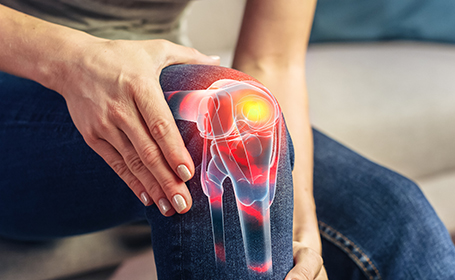Aramis Shop: Your Hub for Stylish Living
Discover the latest trends in home decor, fashion, and lifestyle at Aramis Shop.
Joint Pain: The Sneaky Saboteur of Your Daily Grind
Uncover how joint pain secretly disrupts your daily life and discover effective tips to reclaim your freedom!
Understanding Joint Pain: Common Causes and Symptoms
Joint pain is a prevalent issue that affects individuals of all ages, and understanding its common causes is crucial for effective management. Some of the common causes of joint pain include conditions such as arthritis, bursitis, and tendinitis. Osteoarthritis, the most widespread form of arthritis, results from wear and tear on the joints over time, leading to inflammation and discomfort. Other conditions, such as rheumatoid arthritis, are autoimmune diseases that cause the body to attack its own joint tissues, resulting in severe pain and swelling.
Symptoms of joint pain can vary greatly, depending on the underlying cause. Typical symptoms may include swelling, stiffness, and a decreased range of motion in the affected joint. In some cases, individuals may also experience a sensation of warmth or redness around the joint area. Recognizing these symptoms early on can be vital in seeking appropriate treatment and preventing further complications. It is important to consult a healthcare professional for a comprehensive assessment and tailored treatment options.

How to Combat Joint Pain: Tips for a Pain-Free Daily Routine
Joint pain can significantly impact your daily routine, making even the simplest tasks seem daunting. To combat joint pain, it's essential to incorporate a few effective strategies into your lifestyle. Start by maintaining a healthy weight, as excess pounds can put additional stress on your joints. Alongside this, consider integrating low-impact exercises into your routine, such as swimming or cycling, which help strengthen the muscles around your joints without causing undue strain. Additionally, warmth and heat therapy, like warm baths or heating pads, can provide relief and improve flexibility.
Nutrition also plays a crucial role in managing joint health. Ensure your diet is rich in anti-inflammatory foods, including turmeric, ginger, and omega-3 fatty acids found in fish. Staying hydrated is vital as well, so aim for at least eight glasses of water daily. Lastly, don't forget to prioritize rest and proper sleep, as this helps your body repair and rejuvenate. By establishing these habits, you can create a pain-free daily routine and reclaim the joy of movement.
Is Your Joint Pain Sabotaging Your Sleep? Discover Solutions
Joint pain is a common ailment that can significantly impact your quality of life, especially when it comes to sleep. If you’ve ever tossed and turned at night, unable to find a comfortable position due to nagging discomfort, you’re not alone. Studies suggest that as many as 70% of individuals with chronic joint pain report sleep disturbances. This vicious cycle can lead to a combination of fatigue and increased pain, making it essential to address both issues simultaneously.
Thankfully, there are effective solutions to help manage joint pain and improve your sleep. Consider incorporating the following strategies into your routine:
- Physical Activity: Regular, low-impact exercises like swimming or walking can strengthen the muscles around your joints, reducing pain.
- Heat Therapy: Applying heat through warm baths or heating pads can enhance circulation and ease joint stiffness.
- Sleep Environment: Investing in a supportive mattress and pillows can make a world of difference in achieving a restful night.
- Consult a Professional: Don’t hesitate to talk to a healthcare provider for personalized treatment options, which may include medications or physical therapy.